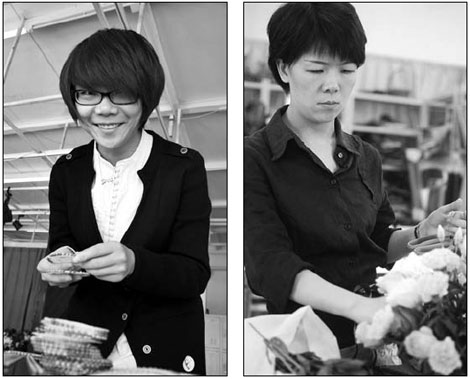From blooms to bouquets
Updated: 2012-01-05 08:02
By Xu Lin (China Daily)
|
|||||||||||
|
A hall features floral decorations for an awards ceremony in Beijing. Photos provided to China Daily |
The floral arrangement industry isn't just about flowers anymore, as the market pushes designers to become multidisciplinary. Xu Lin reports.
Zhang Xinjie snips roses and ties them, upside down, to string dangling from the ceiling.The 35-year-old floral designer from Fuzhou, Fujian province, explains as she decorates the banquet hall how market trends have made her trade more multidisciplinary in recent years.
"Today's floral designer must be versatile and understand the sciences of lighting and color," says Zhang, who has been in the industry for about 14 years.
That's the basis of Beijing's Cohim Fashion Training Organization, which provides professional floral design training, employee Liu Yinxing says.
"Traditional floral art is only about flowers," Liu says.
"But modern floral design is a fusion of lighting, music and floriculture, and focuses on harmony within the environment. It's widely used at weddings, wine parties and banquets."
Liu's center began providing multidisciplinary lessons in 2010.
Most of the nearly 100 trainees are women floral and wedding designers, aged 25 to 35. Zhang, who underwent the 18-day training last June, is one of them.
"I realize the importance of adding other elements to my floral art," Zhang says.
"I've broadened my horizons after systematic study."
Zhang mainly designs for weddings, banquets and real estate company's activities. She travels around the country to work.
She first provides customers with blueprints and revises these until clients are satisfied. Constructing these visions takes from several hours to up to 10 days, she says.
Ensuring the lighting matches the flowers' hues is crucial to wedding design, she says, adding the music must match, too.
"Details count," Zhang says.
"Take a table: Different tables are better for different cuisines. Long tables are for Western cuisine, while round tables are for Chinese food. Then, we can know how much room on the tables is left over for flowers."
Zhang says odorless flowers should be used in Japanese cuisine, which is light and focuses on the food's raw flavors. Fragrant flowers, even perfume, spoil the atmosphere.
"Flowers with a lot of pollen should be used sparingly, because they can blemish bridal gowns or make people with allergies miserable."
Zhang explains that seemingly small details, such as the focus on one flower, can have a huge impact on the whole.
And customer preferences vary among places and individuals.
"Customers in Beijing and Fuzhou are different," she says.
"Beijing has various activities, with more diverse requests and higher requirements. Designers usually do what Fuzhou customers specifically request, while designers have more say in the capital," she continues.
"I used to think about which flowers to use, but now I have more than flowers to decorate with - plastics, wood and steel. The more choices I have, the more fun I have."
Zhang's profession is also luring new practitioners from other careers.
Pan Juan quit her job as an application engineer at a Fortune Global 500 company, in Shanghai, in October, to learn the floral arts.
The 29-year-old spent about 40,000 yuan ($6,328) to study the trade. About half the money went to tuition, and the rest covered daily expenses and flights.
"My previous work was dull, and my passion gradually faded," Pan says.
"Life's short. I want to do what I enjoy, no matter what others think."
Pan has loved flowers since childhood but never worked with them in a professional capacity. So she must learn lighting, color science and flower arrangement from scratch. To enhance her strength, she often takes a bundle of flowers and a bundle of leaves, and tightens them up.
"The difficulty is that I think the lessons are hard, while other classmates think they're easy," she says.
"I have to study more to keep up."
Pan is optimistic about the future. She plans to practice what she has learned in the past two months and start her new career when she's ready.
Taiwan wedding designer Gao Yijing has been impressed by the mainland's rapid development of floral design.
"Designers learn quickly," Gao says.
"The problem is that some tend to copy masters rather than create new works. They are adept at imitations, but it takes time for them to form their own styles.
"We also have to educate customers, some of whom are only concerned about flowers. But floral design isn't just about flowers. The whole space counts."
|
Pan Juan (left) and Zhang Xinjie chose to be floral designers as the occupation gains popularity in big cities. |
Today's Top News
Rescuers race against time for quake victims
Telecom workers restore links
Coal mine blast kills 18 in Jilin
Intl scholarship puts China on the map
More bird flu patients discharged
Gold loses sheen, but still a safe bet
US 'turns blind eye to human rights'
Telecom workers restore links
Hot Topics
Lunar probe , China growth forecasts, Emission rules get tougher, China seen through 'colored lens', International board,
Editor's Picks

|

|

|

|

|

|







